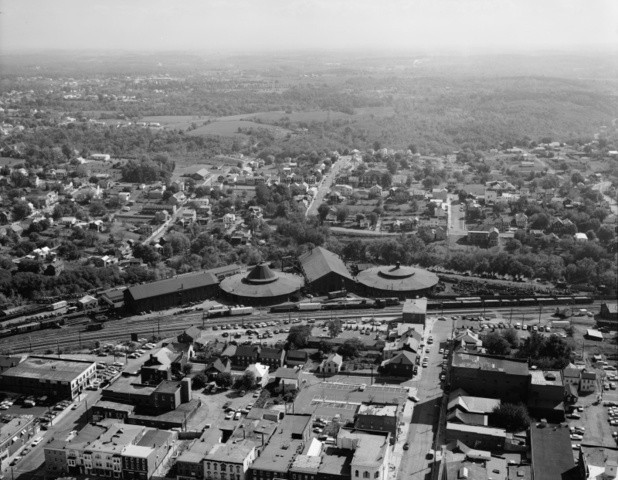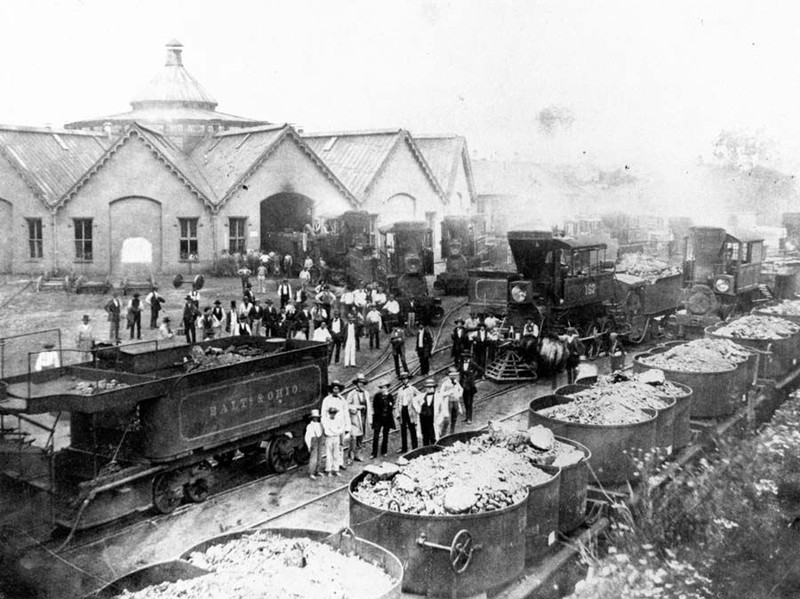Historical Marker: The Great Strike Begins
Introduction
Text-to-speech Audio
Images
Birdseye view of the B&O Roundhouses in Martinsburg, West Virginia.

Depiction of the strike in Martinsburg, West Virginia.

Picture of the B&O station in Martinsburg prior to the Civil War.

Backstory and Context
Text-to-speech Audio
By 1873, when the Great Panic brought about economic despair the United States was still trying to heal from the Civil War. The implementation of Congressional Reconstruction attempted to reunify the country. However, tensions still existed, but a new horizon of difficulties brewed in the labor industry. The Great Panic of 1873 was a global depression that affected many nations. The United States felt the impact from the railroad industry that bottomed out. Resulting from this B&O CEO, John W. Garret announced a wage reduction for all employees and officers employed by the company. B&O railroad employees in Martinsburg, West Virginia angered by another pay cut went on strike.
The train yards in Martinsburg were destroyed during the Civil War and rebuilt from 1866 to 1872. Martinsburg sustained considerable damage during the war but recovered through Reconstruction. The Baltimore & Ohio Company had finished the roundhouses one year before the Great Panic of 1873 trampled the country. The railroad workers in Martinsburg kicked off their strike two days after the announcement of another pay cut. The disruption of train departures led to the mayor sending local militias to aid the Martinsburg Police. The militia and police did not dissuade the strikers from disrupting train departures. Eventually, John W. Garret contacted the governor pleading for federal troops to suppress the strike due to the police force and militia’s refusal to open fire against the strikers. Strikers were supported by the community and a July 24th article from the Martinsburg Statesmen reinforced the community support of the strikers.
The Martinsburg Statesmen article stresses the lack of violence caused by the strike as was portrayed in the Baltimore Sun and other newspapers from surrounding states. The article goes on to describe the morale of the strikers while stating scandalous business practice from the B&O Railroad Company. The strike that started in Martinsburg escalated to Maryland, Pennsylvania, Ohio, Illinois, and California. Strikes in each of these states witnessed diverse groups of people unified against the railroad industry. Laborers, men, women, foreign, Black and white, rallied together showing support for the strikes. The media’s reaction to the strikes according to historian Troy Rondinone adopted a war-time style of reporting learned from the Civil War. “During the Great Railroad Strike, newspapers emphasized several things---the organization of the strikers, the extensive degree of disorder and violence, and (often in editorial sections) the real potential for revolution or social catastrophe.” (Rondinone 398). The Railroad Strike of 1877 lasted for 45 days ending with lackluster results. However, the conscious minds of Americans witnessed the birth of a long struggle between labor and capital.
Cite This Entry
Bryant, Brooks and Clio Admin. "Historical Marker: The Great Strike Begins ." Clio: Your Guide to History. January 19, 2019. Accessed April 27, 2025. https://theclio.com/tour/722/7

